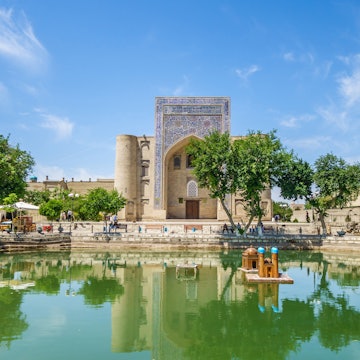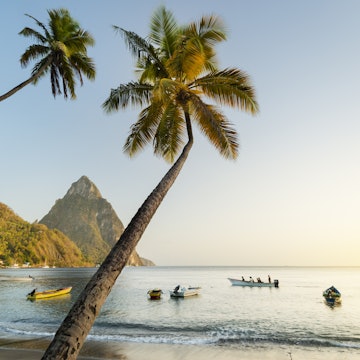
Traveling to Oman on a budget: how to get the best out of your trip

Feb 22, 2022 • 7 min read

Camping in Oman is appealing for the self-sufficient – and the budget-conscious, too © Abie Davies / Shutterstock
Known for its rich cultural heritage, wildly beautiful landscapes and the heart-warming hospitality of its people, Oman is not a country you might associate with traveling on a budget.
After all, it shares borders with the United Arab Emirates, where neighboring Dubai is known for its pricey attractions and experiences geared towards wealthy visitors. But if you’re open to independent travel, it’s easy to go backpacking in Oman or otherwise travel around on a budget.
A first piece of advice: pick the right season for your trip – and don’t even think of visiting in summer (June through August), even if cheap plane fares seem enticing. Given the extremely hot days, you’ll find it nearly impossible to spend them outdoors amid the country’s splendid natural beauty.

If you’re already in the region, a road trip is the cheapest way to get to Oman
Many travelers want to spend a few days exploring Oman after visiting the UAE, with its numerous flight connections. But the cheapest way to get to Oman from the UAE is by car.
Tourists can enter Oman through five land-border crossings with the UAE, of which two are in Abu Dhabi and one each in Dubai, Sharjah and Ras Al Khaimah. Since the borders are sometimes temporarily closed or open only to residents, it’s best to contact Oman’s Ministry of Tourism before you set out.
The drive from Dubai to Muscat takes just over 4 hours. You should have no problems entering Oman through the border checkpoints as long as you meet the COVID-19 vaccination and PCR test requirements. Many nationalities can get a visa on arrival for Oman; otherwise, you can apply online in advance.
You’ll need to inform your car rental company in Dubai about your plans to drive across the border, check that the insurance coverage includes Oman and obtain a “No Objection Certificate” (NOC) – a document that states that you have the rental company’s explicit permission to drive the car across the border to Oman.
Spend time outdoors
There’s a good chance your trip will begin in Muscat – and it’s worth spending a day or two visiting famous sights such as the Mutrah Souq, Sultan Qaboos Grand Mosque, Al Alam Palace and the Royal Opera House Muscat. Unlike its Gulf neighbors, however, Oman’s true highlights lie outside of town, in its extraordinary landscapes.
Top things to do in Oman include the craggy limestone peaks of the Hajar Mountains, wadis (valleys) with turquoise pools and farms, cliff-top villages in Jebel Akhdar and the rocky Ad Dimaniyat islands surrounded by waters full of coral reefs and tropical fish. Luckily, most of these places are free to visit or cost as little as OR5 (US$15) per day where a permit is required.
Skip the tours and travel independently
Even if it’s your first time visiting this part of the Middle East, it’s easy to avoid group tours and travel around Oman without a guide, both of which can be add up quickly. Depending on your interests and how many days you’re visiting, you’ll have no trouble planning an itinerary focused on nature, adventure, culture – or a little bit of it all.
The roads connecting the main towns are in excellent condition and have signs in English. Should you find yourself lost or needing assistance, Omanis are likely to go out of their way to help.
Along the way, if you’re interested in activities that are best done with a guide, such as the climbing the Jebel Shams summit, hiking through Wadi Shab or diving in the Ad Dimaniyat Islands, you can book a day trip or excursion so that you get the most value out of the experience while still allowing yourself the flexibility (and budget-friendliness) of independent travel.

Pack a tent and sleeping bag
Wild camping is free and permitted nearly everywhere on public land in Oman. The country is full of incredibly scenic spots, from white-sand beaches and plateaus with breathtaking canyon views to quiet fishing villages – all beautiful places to pitch your tent and sleep under the stars.
Camping in Oman is safe, which is why it’s also popular with tourists from around the Gulf countries. It isn’t just for tourists, either: many families in Oman often go camping, especially during the cooler months from October to March. If there’s a group camping nearby, don’t be surprised if one or two members (always men) come over to talk, offer tea or even freshly caught fish roasted on a bonfire. Hospitality is a way of Omani life.
Since it can get quite chilly while camping overnight and conditions might be windy on the beaches, bring layers to keep warm. There is a risk of flash floods in the wadis, especially after rain, so keep an eye on the weather forecast and warnings when and where you decide to set up camp.
Camping isn’t allowed in nature reserves like Jabal Samhan and the Ad Dimaniyat Islands without a permit. Additionally, you’re not allowed to camp at the Ras Al Jinz Turtle Reserve or on the Ad Dimaniyat Islands from May through October to protect nesting turtles.
Don’t expect official campgrounds with toilets and showers – camping in Oman is for the self-sufficient. Tents, rooftop tents and camping equipment can be rented from operators like Nomad Tours and Active Oman or bought at supermarkets such as Carrefour and Lulu Hypermarket in Muscat.
Assess your rental car options
Given the limited public transportation in Oman coupled with affordable fuel costs (OR0.25 or US$0.64 per liter), renting a car will afford you the most cost-effective way to get around Oman. Keep in mind, though, that rental costs can vary widely depending upon the type of car you pick.
A 4WD offers maximum convenience and flexibility, allowing access to remote mountain villages and the desert, but it’s much pricier at OR23–96 (US$60–250) per day, compared with renting a 2WD sedan at OR10–20 (US$26–52) per day. To save on costs, consider whether you really need a 4WD.
If you plan on doing a few guided trips or staying overnight at places such as Sharqiya Sands or Jebel Akhdar, a sedan should suffice as most operators and hotels can pick you up from the nearest paved-road-accessible town.
Choose locally owned accommodations
While you’ll find plenty of international hotels in Oman even beyond the big cities, if you want to save on costs, pick hotel apartments and locally owned guesthouses instead. Though not as fancy, hotel apartments are spacious and air-conditioned, come with kitchens you can cook in and include modern amenities like TVs and wi-fi.
Smaller guesthouses are located in villages and housed in traditional stone dwellings, which means they have loads of character. You’ll also enjoy delicious homestyle meals. For a stellar example of the genre, make a reservation at Misfah Guest House in Misfat Al Abriyyin.

There’s a desert camp for everyone, but book well in advance
Many travelers visiting Oman for the first time are keen to spend a night at a desert camp at Sharqiya Sands – and rightly so. Few other experiences compare to watching the sun disappear behind rose-gold dunes and thousands of stars light up the night sky. Not surprisingly, they’re very popular during the peak season (November to March), so even if you otherwise love spontaneity, try to book your desert camp stay well in advance of your trip for the possibility of getting a better deal on rates.
Oman has a wide range of desert camps to choose from, so you’re almost certain to find something that suits your budget. The more luxurious ones, such as the Desert Nights Camp (beginning at OR75 or US$195 per night), have modern, air-conditioned rooms with private bathrooms and showers, and even tented villas with private pools. At cheaper camps such as Bidiyah Desert Camp (beginning at OR29 or US$75 per night), you can still have a great experience even with simpler amenities and food.
You can eat well on a budget
Outside of restaurants in international hotels, eating out in Oman isn’t too expensive. At cafeterias, coffee shops and small family-run restaurants, you’ll find dishes from throughout the Middle East that are both delicious and easy on the wallet. For an affordable breakfast or snack, head to neighborhood bakeries and choose from sandwiches, savory patties, croissants and cakes.
Thanks to a huge migrant population from South Asia, you’ll also find hole-in-the-wall restaurants serving affordable Indian, Pakistani and Nepali dishes like chicken gravy with paratha, biryani and momos.
If you’re staying at a hotel apartment with a kitchen, shop for groceries at supermarkets and cook your meals to keep costs down.
Daily costs in Oman
Private room in a guesthouse: OR15–30 (US$39–78)
Basic hotel room for two: OR15–30 (US$39–78)
Self-catering apartment: OR10-35 (US$26–91)
Public transport ticket: OR2-25 (US$5–65)
Karak chai: 100–200 baisa (US$0.25–0.50)
Shawarma or falafel sandwich: 50 baisa–OR1.50 (US$.15–5)
Dinner for two: OR7-15 (US$18–39)
You might also like:
10 must-see natural wonders in Oman
The top things to do in Oman are out of this world
Wadi and soul: the best hikes in Oman













